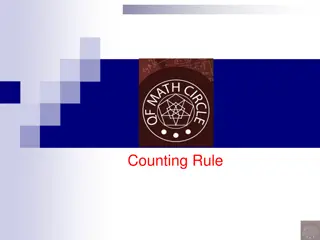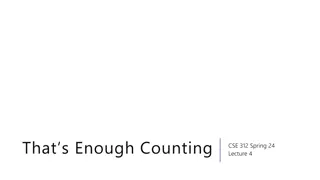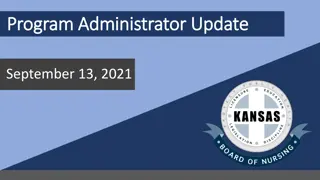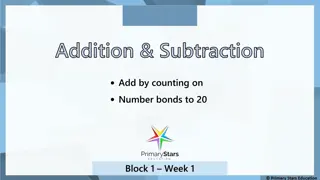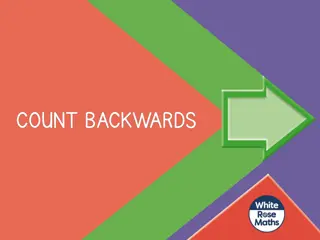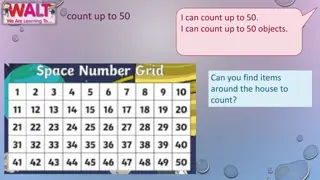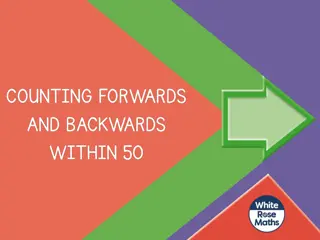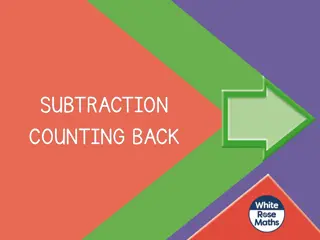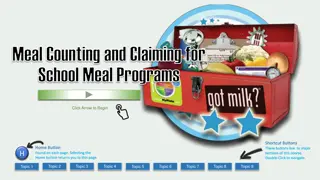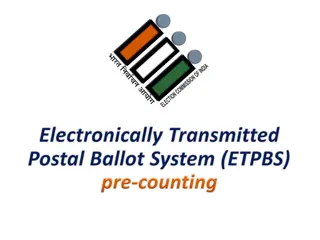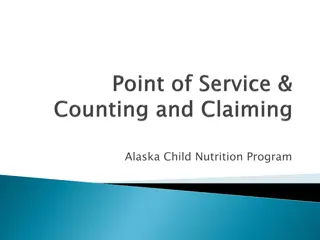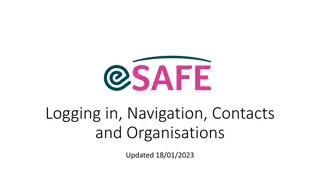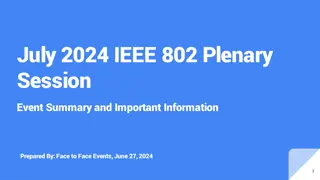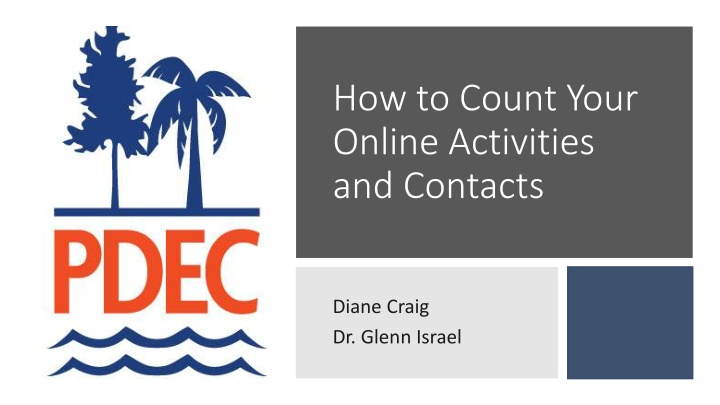
Counting Online Activities and Contacts for Workload Reporting
Learn how to accurately count online activities and contacts for workload reporting in educational settings. Discover guidelines on capturing participants, moderators, and group learning interactions. Find out how to report mentoring programs and online certification programs effectively.
Download Presentation

Please find below an Image/Link to download the presentation.
The content on the website is provided AS IS for your information and personal use only. It may not be sold, licensed, or shared on other websites without obtaining consent from the author. If you encounter any issues during the download, it is possible that the publisher has removed the file from their server.
You are allowed to download the files provided on this website for personal or commercial use, subject to the condition that they are used lawfully. All files are the property of their respective owners.
The content on the website is provided AS IS for your information and personal use only. It may not be sold, licensed, or shared on other websites without obtaining consent from the author.
E N D
Presentation Transcript
How to Count Your Online Activities and Contacts Diane Craig Dr. Glenn Israel
Logistics This session is being recorded. Please turn off your camera if you do not wish to be recorded. Use the chat feature to ask questions.
Includes multiple participants and typically more formal setting than consultations Each faculty member counts attendance at their event or their segment of a larger event External audiences only for Workload (ISTs reported in ROA) Group Learning Participants Online environment: Need some type of registration and ideally collect demographics Can be live or recorded
I am mentoring two Active Learning Program (ALP) UF interns. We met twice a week for 9 weeks and they help me with marketing and research related to my CRD program. I am a new agent, what is the best way to report this activity? Since Workload is only for external audiences (not students or other faculty) it would not go in Workload. Instead, you will report this in your ROA under your CRD program. Discuss with your CED and DED about how to best capture your work with the interns and any evaluation planned.
Florida Friendly Fishing Guide is an online certification program. Guides watch 12 recorded webinars and complete online tests. We estimate it takes about 20 hours to complete the program, which is set up in Canvas. How do I count those contacts? Count the total number as group learning participants one time. If this was done live with the same group and different sessions for different topics, you would count the group participants each time you met. This assumes you know the identity and demographics of your participants. Count each webinar as a separate educational material.
If the online program has a moderator, how is that person captured? If the moderator is simply helping with the technical needs of the virtual event, this would not be counted in Workload. If the moderator is a faculty member and is answering questions and guiding the conversations, they may count the group participants in Workload. Other faculty will also count these participants. If the moderator is support staff or a volunteer, these participants should be reported by the faculty supervising that program.
Since we are now conducting many webinars, and expect that to continue in future, how should we be collecting demographic data? What sort of data should we be collecting? Per Civil Rights guidance in Form AD-2106, you should be collecting a person s name, address, gender, ethnicity and race. Similar to a sign- in sheet at an in-person event, these fields are voluntary. Use these Zoom guidelines on how to set up a registration page with demographic questions. Similar questions can be asked in registration for events using Microsoft Teams and Google Sites.
Civil Rights Requirements for Race and Ethnicity
Must convey research-based educational content Events and activities that do not have some type of registration or way to identify participants Use the Workload FAQ to find the appropriate metrics to pull Includes Facebook, Instagram, YouTube, Includes posts, videos, blogs, podcasts Social Media Contacts
When we are broadcasting video onto social media from a webinar, how do we count those indirect views? These would be counted as social media contacts rather than group learning participants since you do not have information about the individual viewers. Use the social media analytics to view the number of video viewers. Look at the individual video stats rather than overall viewers since that counts anyone who was on for at least 3 seconds. If there is a significant drop-off between those who started it and those who finished, use the number of viewers that best represent those who completed the video session. (If a person engages with your video/blog/post, those data can also be counted as social media contacts in addition to your viewers.)
Do podcasts need to be formatted a particular way or hosted on a particular platform to enable counting? Also, is there any way to obtain demographic or geographic data on listeners, or is the only possible metric that can be reported the total number of listeners? All podcast hosting platforms should have basic analytics the show the total plays and unique listeners for a given timeframe. The Total Plays metric is recommended to use to count as social media contacts. Like videos, you don t know how long they listened unless you look at a specific episode. If you can look at an episode or several episodes and see there is no significant drop-off then use the Total Plays. Otherwise, you can estimate the number of social media contacts based on retention statistics. Social media and podcast hosting site analytics will provide demographics about some viewers, but this is not sufficient for Civil Rights purposes since it is not collected at the individual participant level. It is very useful for understanding your audience and your reach, and perhaps using it to describe you estimated audience in an impact statement.
How can I use newer technologies like Facebook Live, Google sites, and podcasts but capture the demographics I need for demonstrating parity and meeting Civil Rights guidelines? Use Mailchimp or similar email program to distribute a podcast or webinar Use Eventbrite and have them register for a free event Direct participants to a website that hosts your video and podcasts and require them to log in to listen Include a survey link during your video or episode to capture information about your participants In smaller events, you can assign someone to capture names of participants. This is most likely used when it is a known group and you already have their demographics on file. Have a Q&A during the event that encourages participants to comment or chat
How do I report extension programming delivered through Google Sites? If the site is open to the public with no registration, count the unique visitors in Google Analytics as your social media contacts. If you want to count them as Group Learning Participants, you need to have some type of registration page. Some have used Eventbrite for this purpose. If the meeting is open to anyone, the attendees could still share the link you provide to registered participants with others. If you set up your Eventbrite to close prior to the event, the link would only be valid for known registrants.
Generally, one or a few related participants and informal Includes diagnostics, if you also provide educational information Field vs. office depends on where the visit takes place Field and office visits can be virtual or face- to-face Should collect demographics on your clientele Field and Office visits
We offered a Virtual Office Hours session on Zoom every other week for a few weeks to fill the gap left when our Master Gardener Volunteer Plant Clinic Desk was closed to due to Covid. It was open to anyone who wanted to join in. Some people took us on a virtual tour of their yard, some participated by asking questions, and others just attended but did not engage. Not everyone had their camera turned on. Treat these as if they had happened pre-pandemic. These can be counted as field visits for those who showed their yard and diseased plants, and as office visits for those who just attended during office hours. Ideally, there should be a registration for Zoom events to capture the demographics and identity of the participants, but those guidelines were not in place early in the pandemic.
Must convey research-based educational content Multiple exchanges on the same topic equals one contact Includes newsletters and information sent out via a service like Mailchimp you have some knowledge that they opened or read it Otherwise, the distribution of newsletters through email listserv or SMS, is reported in your ROA but not Workload Phone, Email and Text Consultations
Since Covid began, I have sent about 40 informational emails (more like an informal newsletter) to my farmer/rancher email group. They were focused on the pandemic and need to know information but eventually morphed into a more traditional format. I received very positive feedback from my original email group but also learned the early emails or pieces of it were distributed through industry groups, a retail store, county govt., etc. Typically, the distribution of an informal newsletter is similar to that of a formal newsletter it should only be counted as an email consultation if you are reasonably assured that they actually read it. For emailed newsletters like this, we encourage the use of MailChimp or similar software so you can count the number of click-throughs or open rate as email consultations. That said, given the great deal of uncertainty in the early days of the pandemic and your general sense that they were found to be very useful to that audience, we would count all the early emailed newsletters as an email consultation but not the later ones with the more traditional type of information. (This organic distribution of your information and growth in your emails list as a result is a good impact statement!)
Clientele contacts are educational contacts you are relaying research-based information Remember to report the contacts made by others on your behalf (i.e., program staff, volunteers) Online activities need registration of some type and ideally, capture demographics if you want to count participants as group learning participants Even if we don t ask for race/ethnicity/gender in Workload, you are expected to collect and store these data on participants Key Takeaways for Reporting Contacts
Resources http://pdec.ifas.ufl.edu/workload


